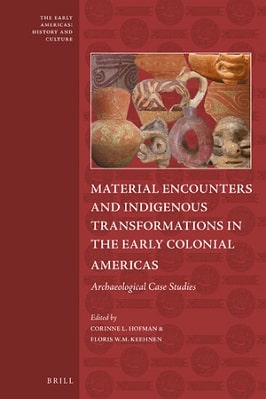
| Book Title | Material Encounters And Indigenous Transformations In The Early Colonial Americas |
| Book Author | Corinne L. Hofman |
| Total Pages | 421 |
| Book Views | |
| Language | English |
| Book Download | PDF Direct Download Link |
| Get Hardcover | Click for Hard Similar Copy from Amazon |
Material Encounters and Indigenous Transformations in the Early Colonial Americas Archaeological Case Studies
Edited by Corinne L. Hofman – Floris W.M. Keehnen
MATERIAL ENCOUNTERS AND INDIGENOUS TRANSFORMATIONS IN THE EARLY COLONIAL AMERICAS ARCHAEOLOGICAL CASE STUDIES
In a notable article on the perils of typological nomenclature as applied to the European colonial era, Stephen Silliman (2005) took me and other North American scholars to task for our reliance on the expression “contact” – as in contact-period archaeology.
As he observed, by using the term contact rather than colonialism, archaeologists were in danger of emphasizing short-term encounters over entanglements, eliding the relations of power and inequality more directly implied by the concept of colonialism, and focusing on pre-defined traits over processes of hybridization and creolization.
There clearly is good merit to Silliman’s concerns over the conflation of the notions of contact and colonialism.
What perhaps got overlooked in his argument, however, is that North American archaeologists primarily use contact as short-hand for the first century or so of interactions between Native American and European cultures. It is not usually meant as a brief encounter shorn of history, domination, and resistance.
Certainly, concepts like “contact” or “protohistoric” – and “conquest period” as frequently seen in this volume – do carry considerable semantic freight and we must be wary in how we use them.
Nevertheless, I still maintain that it is extremely useful to delineate distinctive chronological and spatial pulses in the colonial experience. And I am gratified to say that I think the contributions to this pathbreaking volume support my argument.
The “Early Colonial Americas” alluded to in the title – more or less spanning the late 1400s to early 1600s CE in the larger circum-Caribbean region – embody relations between Native Americans and Europeans that are wholly different than for other times and places.
The authors demonstrate that the earliest phase of European colonialism in the Americas was manifested as a highly uneven event. The event can be characterized as a large wave of conquistadores, clergy, and colonists – largely from Iberia – rapidly roiling into a newfound world in the decades following Columbus’ first landing in 1492.
Moving down from a panoramic to a historically granular viewpoint, though, it is obvious that any hope of regimenting this westward surge by the Spanish or Portuguese Crowns was thwarted by the complex personalities and objectives that comprised the many expeditions and colonies.
Equally important, the immense variety of indigenous societies that awaited guaranteed that each European landing on the American mainland and the Caribbean islands would spark a unique trajectory of cultural interactions. In the material world, the outcome was a form of normative
To read more about the Material Encounters And Indigenous Transformations In The Early Colonial Americas book Click the download button below to get it for free
Report broken link
Support this Website
Click here to join our Telegram group for new Books